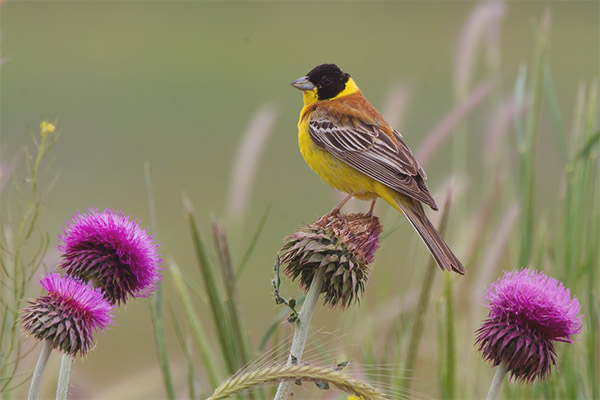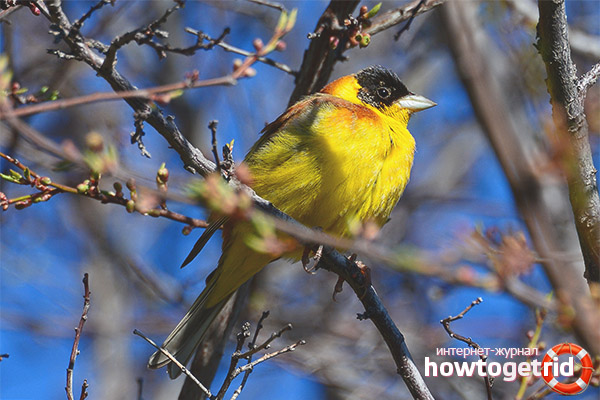The content of the article
Black-headed porridge lives in Asia, on the European part of the continent and in many regions of Russia. She was brought to New Zealand, where she quickly acclimatized and successfully settled down. Cheerful disposition and bright coloring make this close relative of the sparrow a welcome guest anywhere. The number of birds is large enough and extinction does not threaten them.
Appearance and habits of black-headed oatmeal
The size of the bird is not much different from the common sparrow. The tail in relation to the body is rather long, with a small notch. The bird confidently keeps on strong legs, the beak is small, thick, adapted for pecking seeds of wild-growing herbs. An elegant look gives it a bright yellow color of the head, breast, throat and abdomen. Top and sides of the head are black, on the back and wings turning into a dark - chestnut shade with thin stripes on the wings. It looks like a male.The female is much more modest and her outfit is made up of inconspicuous shades of brown with small patches of olive and black.
Birds of this species prefer to settle on open plain spaces. They are attracted by low hills, rugged ravines, steppes, gardens and fields. Avoid low-lying places with high humidity. Black-headed porridge does not want to go on foot and strive to fly even over short distances. Flight pattern is uneven, with sharp turns. The nature of birds is not conflict, so they live in peace in large colonies, build nests nearby from each other.
The basis of the diet consists of bluegrass, nettle, sorrel, clover, forget-me-not, dandelion, plantain seeds. Oatmeal is happy to feast on oats and barley grains. Sometimes it dilutes the menu with insects. The mating season requires a lot of energy, so grasshoppers, spiders, beetles and caterpillars are eaten. Black-headed Bunting refers to migratory birds, does not like cold weather, and already at the end of August begins to set off on a journey, training the young for endurance.
Marriage games and care for offspring
Soon after the spring arrival, the males begin a period of courtship. Their songs are simple, but the birds know many different variations of the same melody, which turns their performance into a real concert, before which they simply cannot resist the females. Bunting nest build a solid, deep, hiding it in the middle of the bush at a short distance from the ground. The inner surface is lined with thin blades of grass and horsehair.
In a cozy space accommodated 4 - 5 eggs. Sometimes there are more, but then the strongest chicks survive. They are born after 2 weeks, and after another 14 days they begin to stand on the wing, trying their strength. Oatmeal babies are fed with semi-digested food, the male takes minimal part in caring for the offspring. If a potential threat to the chicks appears next to them, the parents fall to the ground and begin to depict wounded animals in order to divert the danger to themselves, gradually leading them away from the nest.
Birds and interesting facts
Black-headed buntings, despite their friendly disposition, are rather secretive. They arrive at the end of April - the middle of May and already at the end of the summer they are almost not visible. Therefore, many facts are not confirmed.But it is known for sure that:
- In birds, there are cases of bigamy, when the male kicks two females simultaneously.
- Karl Linney gave the bird the specific name "Citrinella", which translates as "lemon."
- Oatmeal in one hour can perform up to 300 songs.
- Well acclimatized in captivity, are considered songbirds.
- Term life is 3 - 4 years, but there were record-breakers who managed to live to 13 years.
The natural enemies are crows, birds of prey, foxes, cats. They cause especially great damage during the period when the chicks have not yet fledged or are just beginning to fly.
The ringing and bright little bird flashes with a twinkle among the branches, often flying into the fields and into the garden. In the spring, she pleases with a song, praising the awakening of nature, and at the end of summer she says goodbye until next year, setting off on a long journey to the Mediterranean coast.
Video: Black-headed Bunting (Emberiza melanocephala)












To send